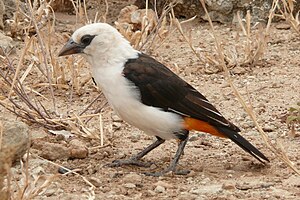Star weaver
| Star weaver | ||||||||||||
|---|---|---|---|---|---|---|---|---|---|---|---|---|

Star weaver ( Dinemellia dinemelli ) |
||||||||||||
| Systematics | ||||||||||||
|
||||||||||||
| Scientific name of the genus | ||||||||||||
| Dinemellia | ||||||||||||
| Reichenbach , 1863 | ||||||||||||
| Scientific name of the species | ||||||||||||
| Dinemellia dinemelli | ||||||||||||
| ( Rüppell , 1845) |
The star weaver ( Dinemellia dinemelli ) is a species from the family of weaver birds. It occurs exclusively in East Africa. There are two subspecies. The IUCN classifies the star weaver as ![]() (= Least Concern - not endangered).
(= Least Concern - not endangered).
Appearance
The star weaver is a starling, powerful weaver bird . He reaches a body length of 18 centimeters. There is no sexual dimorphism .
The head and neck are white, the coat is dark brown. The rump and the tail-coverts are red or orange. The chin, throat, chest, flanks and stomach are white, while the thighs are brown. Young birds are similar to adult birds, but their tail covers are pale orange.
There are two subspecies , D. d. dinemelli in the north of the distribution area and the largely black D. d. boehmi . Confusion possibilities especially with the African barbets zählendem white-headed barbet . However, this lacks, among other things, the red-orange to red rump.
Distribution area and habitat
Its habitat are the thorn savannahs and loose acacia forests in the northeast of the African continent ( Somalia , Ethiopia , South Sudan , Kenya , Tanzania ). Generally it can only be found at altitudes below 1,400 meters. It is rare on grasslands and along river beds.
Way of life and exposure
Star weavers live in pairs or in small groups, often in company with three-colored gloss starlings ( Lamprotornis superbus ). They look for their food mainly on the ground between acacias and thorn bushes. Star weavers breed in loose colonies in thorny trees. The nests are built messily from thorny twigs and have an entrance opening that faces down. They are softly padded inside. The nests are very large and can be up to half a meter long. The clutch consists of three to four eggs that are grayish white or pale blue and have brown spots. In Sudan, the breeding season of the star weaver falls from August to September and December. In Ethiopia, on the other hand, it breeds in the period April to August. The reproductive biology of this species has not yet been adequately studied. For example, the incubation period is not known. In star weavers kept in captivity, both parent birds fed the nestlings and drove other birds out of the vicinity of the nest. The nestling period is at least 14 days.
According to the IUCN , the star weaver is common, at least in parts of its large distribution area, and is not an endangered species ( least concern ).
supporting documents
literature
- Frieder Sauer : African birds recognized by color photos. Fauna, Karlsfeld 1985, ISBN 3-923010-05-2 .
- Christopher M. Perrins : The Great Encyclopedia of Birds. From the English, Orbis-Verlag, Munich 1996, ISBN 3-572-00810-7 .
- C. Hilary Fry , Stuart Keith (Eds.): The Birds of Africa. Volume VII. Christopher Helm, London 2004, ISBN 0-7136-6531-9 .
Individual evidence
- ↑ Fry et al., P. 54
- ↑ Lester L. Short, Jennifer FM Horne: Toucans, Barbets and Honeyguides - Ramphastidae, Capitonidae and Indicatoridae . Oxford University Press, Oxford 2001, ISBN 0-19-854666-1 , p. 194
- ↑ Fry et al., P. 55
Web links
- Dinemellia dinemelli in the endangered Red List species the IUCN 2009. Posted by: BirdLife International, 2009. Retrieved on November 5 of 2009.
- White-headed Buffalo-weaver videos in the Internet Bird Collection

